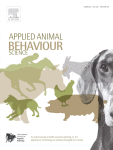Ver ítem
- xmlui.general.dspace_homeCentros e Institutos de InvestigaciónCIAP. Centro de Investigaciones AgropecuariasInstituto de Investigación Animal del Chaco SemiáridoArtículos científicosxmlui.ArtifactBrowser.ItemViewer.trail
- Inicio
- Centros e Institutos de Investigación
- CIAP. Centro de Investigaciones Agropecuarias
- Instituto de Investigación Animal del Chaco Semiárido
- Artículos científicos
- Ver ítem
Development of a welfare assessment protocol for practical application in Argentine feedlots
Resumen
The intensification of livestock farming has led to the expansion of feedlots in many countries and Argentina is not an exception. As in any other husbandry context, there is a need to objectively adopt an evidence-based approach to monitoring animal welfare in feedlots. This research aimed to describe the stages that took part in the development process of Bienest.AR, a beef cattle evaluation protocol adapted to the different conditions of the national
[ver mas...]
The intensification of livestock farming has led to the expansion of feedlots in many countries and Argentina is not an exception. As in any other husbandry context, there is a need to objectively adopt an evidence-based approach to monitoring animal welfare in feedlots. This research aimed to describe the stages that took part in the development process of Bienest.AR, a beef cattle evaluation protocol adapted to the different conditions of the national feedlots, respecting validity, reliability, and feasibility criteria. The process to achieve this goal included the following seven stages: 1- Identification of welfare indicators considering animal- (ABM), resource- (RBM) and management-based measurements (MBM), by organising them according to the FAWC Five Freedoms, the Five Domains Model, and the welfare principles and criteria applied by Welfare Quality® and AWIN methods; 2- Validation of Gold Standards; 3- Evaluator’s training and first reliability testing by Spearman's Rank correlation coefficient; 4- Selection of indicators through focus groups; 5- Field application on 25 farms; 6- Feasibility and second reliability testing by Kendall Correlation Coefficient; and 7- Weighing of indicators and defining the classification method. Of the 150 candidate measurements initially obtained from the literature review, 57 were pre-selected and 28 were finally selected based on their validity, reliability and practicality to integrate the final protocol (18 ABM, 8 RBM and 2 MBM). In addition, the final protocol included information about: preliminary interview; sampling order; estimated evaluation time; sample size; equipment required; and steps to follow from arrival at the farm until completion of the evaluation. The protocol was applied in 25 feedlots and 54,238 animals, and required a minimum time of 290 min to a maximum of 495 min to be completed. Statistically significant (p < 0.05) concordance among the observers was found for all the selected ABM analysed using Spearman's rank correlation coefficient. Given the simplicity for its evaluation, the reliability of RBM and MBM included in this protocol has not been evaluated. This research allowed the development of the first standard welfare assessment protocol for beef cattle feedlots in Argentina. Further applications of the described welfare assessment tool in many feedlots will reinforce the validation of the proposed measurements and allow the diagnosis of the global situation of animal welfare in feedlots in Argentina and other countries applying comparable fattening systems.
[Cerrar]

Autor
Racciati, Debora Silvia;
Bottegal, Diego Nicolas;
Aguilar, Natalia M. Alejandra;
Menichelli, Marcela Liliana;
Soteras, Trinidad;
Zimerman, Maria;
Cancino, Andrea Karina;
Marcoppido, Gisela Ariana;
Blanco-Penedo, Isabel;
Pallisera Lloveras, Joaquim;
Langman, Leandro Ezequiel;
Fuente
Applied Animal Behaviour Science 253 : 105662 (August 2022)
Fecha
2022-08
Editorial
Elsevier
ISSN
0168-1591
Formato
pdf
Tipo de documento
artículo
Palabras Claves
Derechos de acceso
Embargado
 Excepto donde se diga explicitamente, este item se publica bajo la siguiente descripción: Creative Commons Attribution-NonCommercial-ShareAlike 2.5 Unported (CC BY-NC-SA 2.5)
Excepto donde se diga explicitamente, este item se publica bajo la siguiente descripción: Creative Commons Attribution-NonCommercial-ShareAlike 2.5 Unported (CC BY-NC-SA 2.5)

